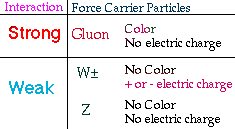 Different Interactions
Different Interactions




Both strong and weak interactions cause particle decays.
Before explaining
some differences between these interactions,
it is necessary to redefine a few
key terms.
-
Electromagnetic Charge:
- Particles with
electromagnetic charge
attract particles with opposite electric charge,
and repel particles with similar charges. The
electromagnetic interaction has been unified with the weak interaction into
the Electroweak interaction.
-
Color Charge:
- Just as some particles can be electromagnetically charged,
other particles
have a different kind of charge called
color charge. The strong interaction
causes the attraction between color charged particles.
-
Flavor:
- A particle's type is referred to as its "flavor."
If a particle decays from one type to another it "changes flavor."
When a down quark decays into an up quark it would be incorrect to say
that the down quark suddenly ceased to be; instead, the down quark
changed flavor.

The force carrier for the strong interaction is the electrically
neutral, color-charged gluon.
The force carriers for the weak interaction are the
W+
(electrically positive),
W- (electrically negative),
and the Z (no electric charge).
None of the weak force-carrier particles are color charged.

Typically, the weak force-carrier particles
(W±) mediate decays in which
particles change electric charge. This usually happens whenever a particle
changes flavor.
The strong force-carrier particle (the
gluon) mediates decays involving a color change.
Strong interactions, being stronger, happen faster than weak interactions.


 Look at more information and pictures which use the example of
neutron beta decay to explain the weak interaction.
Look at more information and pictures which use the example of
neutron beta decay to explain the weak interaction.

![]()